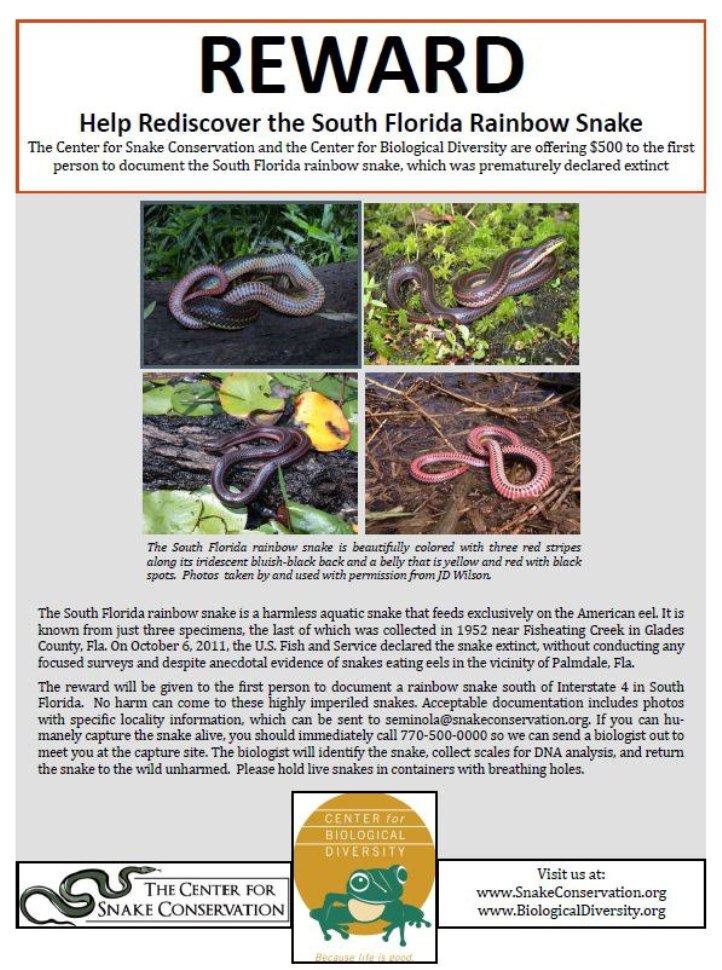
November 9, 2012
Any enterprising Skunk Ape hunters out there want to earn a $500 reward for finding a South Florida Rainbow Snake whilst on your Skunk Ape research expeditions? This species is known from only three specimens, the last documented in 1952 and declared extinct in 2011.

The Common Rainbow Snake (Farancia erytrogramma erytrogramma) and the South Florida Rainbow Snake (Farancia erytrogramma seminola) are some of the most beautiful and unique snakes in the southeastern United States. Snake scientists all agree that both subspecies have declined significantly across their ranges. In many parts of the range, rainbow snakes have not been seen in over 50 years—the South Florida Rainbow Snake was last officially documented in 1952. The destruction of 1st and 2nd order streams, channelization of larger streams and rivers, and the decline of the American eel (Anguilla rostrata) are confounding factors in the loss of rainbow snake populations.
Snakes play important roles in our natural ecosystems as mid- and top-level predators. In particular, rainbow snakes play a very unique role in the aquatic ecosystem in the southeastern United States—they have a specialized diet of American eels as adults. The range-wide decline of rainbow snakes suggests that there have been changes in the habitat, a reduction of eels, exposure to some dangerous pollutant, or some unknown factor affecting the health of the ecosystems they inhabit. While we do not know very much about this species of snake, as a top level predator, we can assume that the presence of rainbow snakes in an area indicates a healthy ecosystem. Rainbow snakes may also be good indicators of global health since they prey upon eels. Eels are global residents spreading their complex life cycles across many different habitat types. They (eels) grow up in our local streams but can be affected by global pollutants in our rivers, estuaries, and oceans during their migrations from their breeding grounds in the middle of the Atlantic Ocean.
The Center for Snake Conservation (CSC) has launched efforts to begin to understand the roles of rainbow snakes in our ecosystems and their indication of global health. Habitat protection and management alone are not enough to ensure the long-term survival of one of our most beautiful snakes and interesting predators. While access to good quality habitats is essential, we need to have healthy streams, rivers, estuaries, and oceans to ensure that eels will be present in the future for rainbow snakes to eat. One goal is to develop repeatable and effective survey methods to detect the presence of rainbow snakes in an area. Rainbow snakes can be difficult to find and often remain undetected. For example, the Common Rainbow Snake was rediscovered by chance in 2005 in Maryland where it was formerly believed to be extirpated. This rediscovery provides hope that rainbow snakes are still present in areas where they historically occurred but we lack the detection methods to adequately locate them in their aquatic habitats.
The CSC has also initiated efforts to rediscover the South Florida Rainbow Snake in 2012 and establish a conservation program intended to insure the long term survival of this unique sub-species.Center for Snake Conservation
About Craig Woolheater
Co-founder of Cryptomundo in 2005.
I have appeared in or contributed to the following TV programs, documentaries and films:
OLN's Mysterious Encounters: "Caddo Critter", Southern Fried Bigfoot, Travel Channel's Weird Travels: "Bigfoot", History Channel's MonsterQuest: "Swamp Stalker", The Wild Man of the Navidad, Destination America's Monsters and Mysteries in America: Texas Terror - Lake Worth Monster, Animal Planet's Finding Bigfoot: Return to Boggy Creek and Beast of the Bayou.
Filed under Bigfoot Report, Cryptotourism, Cryptozoologists, Cryptozoology, Extinct, Sasquatch, Skunk Apes, Swamp Monsters